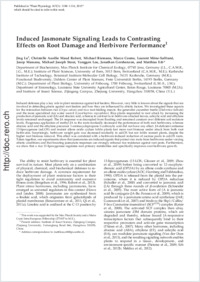Induced jasmonate signaling leads to contrasting effects on root damage and herbivore performance
- Lu, Jing Department of Biochemistry, Max Planck Institute for Chemical Ecology, Jena, Germany
- Robert, Christelle Aurélie Maud Department of Biochemistry, Max Planck Institute for Chemical Ecology, Jena, Germany - Institute of Plant Sciences, University of Bern, Switzerland
- Riemann, Michael Karlsruhe Institute of Technology, Botanical Institute-Molecular Cell Biology, Karlsruhe, Germany
- Cosme, Marco Functional Biodiversity, Dahlem Center of Plant Sciences, Freie Universität Berlin, Germany
- Mène-Saffrané, Laurent Department of Plant Biology, University of Fribourg, Switzerland
- Massana, Josep Department of Plant Biology, University of Fribourg, Switzerland
- Stout, Michael Joseph Department of Entomology, Louisiana State University Agricultural Center, Baton Rouge, USA
- Lou, Yonggen Institute of Insect Science, Zijingang Campus, Zhejiang University, Hangzhou, China
- Gershenzon, Jonathan Department of Biochemistry, Max Planck Institute for Chemical Ecology, Jena, Germany
- Erb, Matthias Department of Biochemistry, Max Planck Institute for Chemical Ecology, Jena, Germany - Institute of Plant Sciences, University of Bern, Switzerland
-
01.03.2015
Published in:
- Plant Physiology. - 2015, vol. 167, no. 3, p. 1100–1116
English
Induced defenses play a key role in plant resistance against leaf feeders. However, very little is known about the signals that are involved in defending plants against root feeders and how they are influenced by abiotic factors. We investigated these aspects for the interaction between rice (Oryza sativa) and two root-feeding insects: the generalist cucumber beetle (Diabrotica balteata) and the more specialized rice water weevil (Lissorhoptrus oryzophilus). Rice plants responded to root attack by increasing the production of jasmonic acid (JA) and abscisic acid, whereas in contrast to in herbivore-attacked leaves, salicylic acid and ethylene levels remained unchanged. The JA response was decoupled from flooding and remained constant over different soil moisture levels. Exogenous application of methyl JA to the roots markedly decreased the performance of both root herbivores, whereas abscisic acid and the ethylene precursor 1-aminocyclopropane-1-carboxylic acid did not have any effect. JA-deficient antisense 13-lipoxygenase (asLOX) and mutant allene oxide cyclase hebiba plants lost more root biomass under attack from both root herbivores. Surprisingly, herbivore weight gain was decreased markedly in asLOX but not hebiba mutant plants, despite the higher root biomass removal. This effect was correlated with a herbivore-induced reduction of sucrose pools in asLOX roots. Taken together, our experiments show that jasmonates are induced signals that protect rice roots from herbivores under varying abiotic conditions and that boosting jasmonate responses can strongly enhance rice resistance against root pests. Furthermore, we show that a rice 13-lipoxygenase regulates root primary metabolites and specifically improves root herbivore growth.
- Faculty
- Faculté des sciences et de médecine
- Department
- Département de Biologie
- Language
-
- English
- Classification
- Biological sciences
- License
-
License undefined
- Identifiers
-
- RERO DOC 234855
- DOI 10.1104/pp.114.252700
- Persistent URL
- https://folia.unifr.ch/unifr/documents/304187
Statistics
Document views: 78
File downloads:
- pdf: 248
